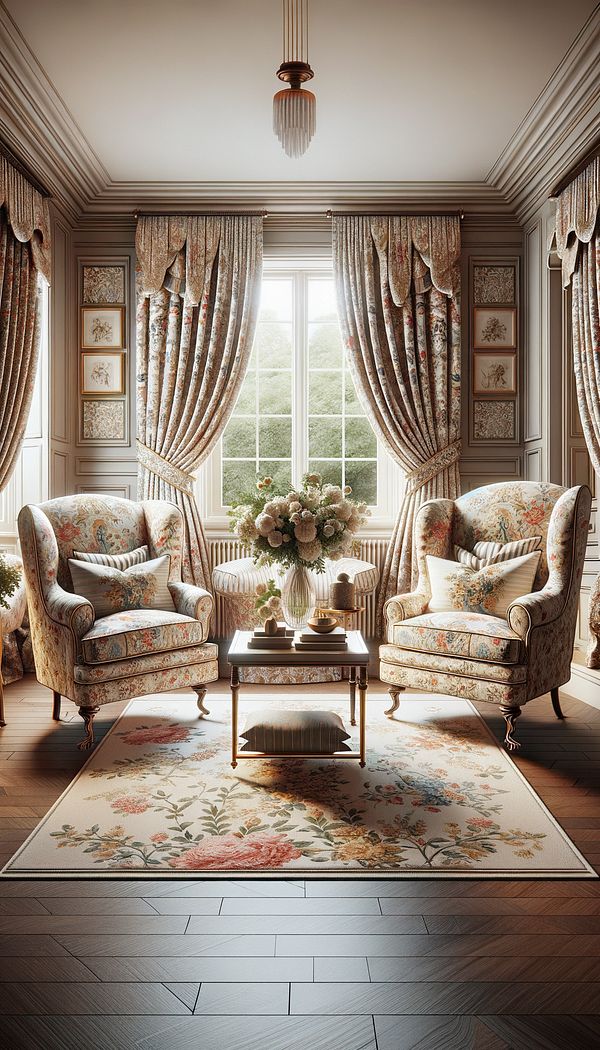What is Chintz?
Chintz is a cotton fabric known for its glazed finish and elaborate floral patterns.
Description
Chintz refers to a type of textile that has its origins in the 17th century, originally imported from India to Europe. Characterized by its tightly woven cotton base and glazed surface, chintz is most commonly recognized for its vibrant and detailed floral designs, though it can also depict other motifs such as animals and scenes. The glazing process, which gives chintz its distinctive sheen, involves multiple layers of starch or resin. This not only imparts a shiny appearance but also adds a measure of stiffness to the fabric, enhancing its durability.
In interior design, chintz plays a pivotal role in adding color, texture, and an element of luxury to spaces. It is often used in upholstery, draperies, and other decorative accessories within a variety of design aesthetics, including traditional, country, and shabby chic. Its versatility and wide range of patterns make it a popular choice for adding sophistication and visual interest to interior spaces.
Despite its traditional connotations, modern interpretations of chintz have embraced more contemporary patterns and color palettes, allowing it to blend seamlessly into modern interior designs as well. This demonstrates the enduring appeal and adaptability of chintz in the evolving landscape of interior design.
Usage
Chintz is frequently found in the upholstery of sofas and armchairs, as well as in the fabrication of curtains, cushions, and wall coverings. It's also a popular choice for bedding sets and table linens, adding a touch of elegance and vibrancy to any room. In historic homes, chintz can be seen adorning the interiors in a manner that reflects the period's styling and opulence.
FAQs
-
Is chintz fabric only suitable for traditional interiors?
No, chintz fabric is not limited to traditional interiors. While it has historical roots, modern variations of chintz incorporate contemporary patterns and colors, making it versatile for both traditional and modern settings.
-
Can chintz be used in every room of the house?
Yes, chintz can be used in nearly any room of the house. Its application ranges from living room upholstery and dining room curtains to bedroom linens and bathroom accessories, providing continuity and charm throughout a home.
-
How do I care for chintz fabric?
Care for chintz fabric typically involves dry cleaning to maintain its glazed finish and vibrant colors. It's important to refer to the care instructions specific to the chintz you have, as treatments may vary depending on the manufacturing process.
-
Are there eco-friendly chintz options available?
Yes, eco-friendly chintz options are available, made from organic cotton and employing non-toxic dyes and glazes. These sustainable choices offer an environmentally conscious option without compromising on style or quality.
Practical Application
When incorporating chintz into your interior design, consider the scale and color of the pattern in relation to the size of the room and its color scheme. Opting for smaller patterns in a large room can create a subtle, cohesive look, while larger, bolder patterns may serve as a dynamic focal point in smaller spaces. Additionally, balance the ornate nature of chintz with simpler, textured materials to create a harmonious and layered aesthetic.
-
Design Styles478 articles
-
Decorative Techniques322 articles
-
Decorating Principles & Elements330 articles
-
Materials & Textiles360 articles
-
Textiles & Upholstery252 articles
-
VeneerVeneer is a thin layer of wood or other material applied over a base surface.
-
Mat BoardMat board is a thick, paper-based material used for framing art.
-
RhythmRhythm in interior design refers to the visual flow and repetition of elements to create a sense of organized movement.
-
ParquetParquet is a geometric mosaic of wood pieces used for decorative flooring.
-
Building EnvelopeThe physical barrier that separates the interior of a building from the exterior environment.
